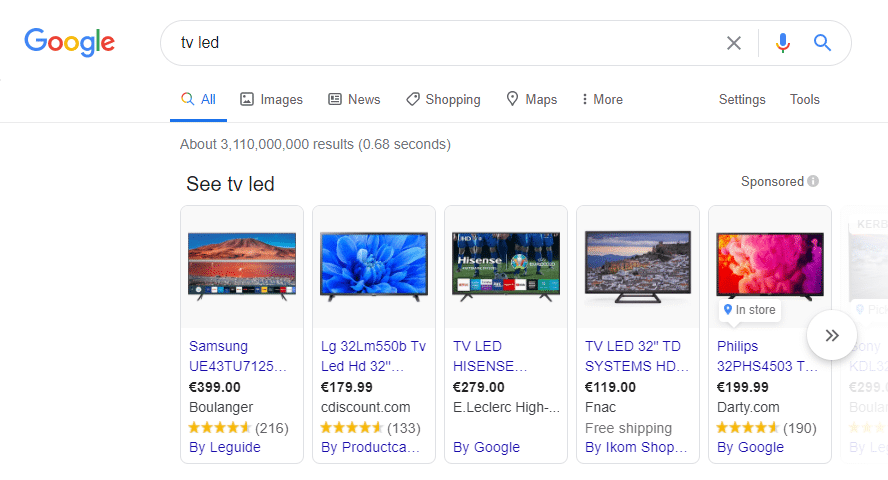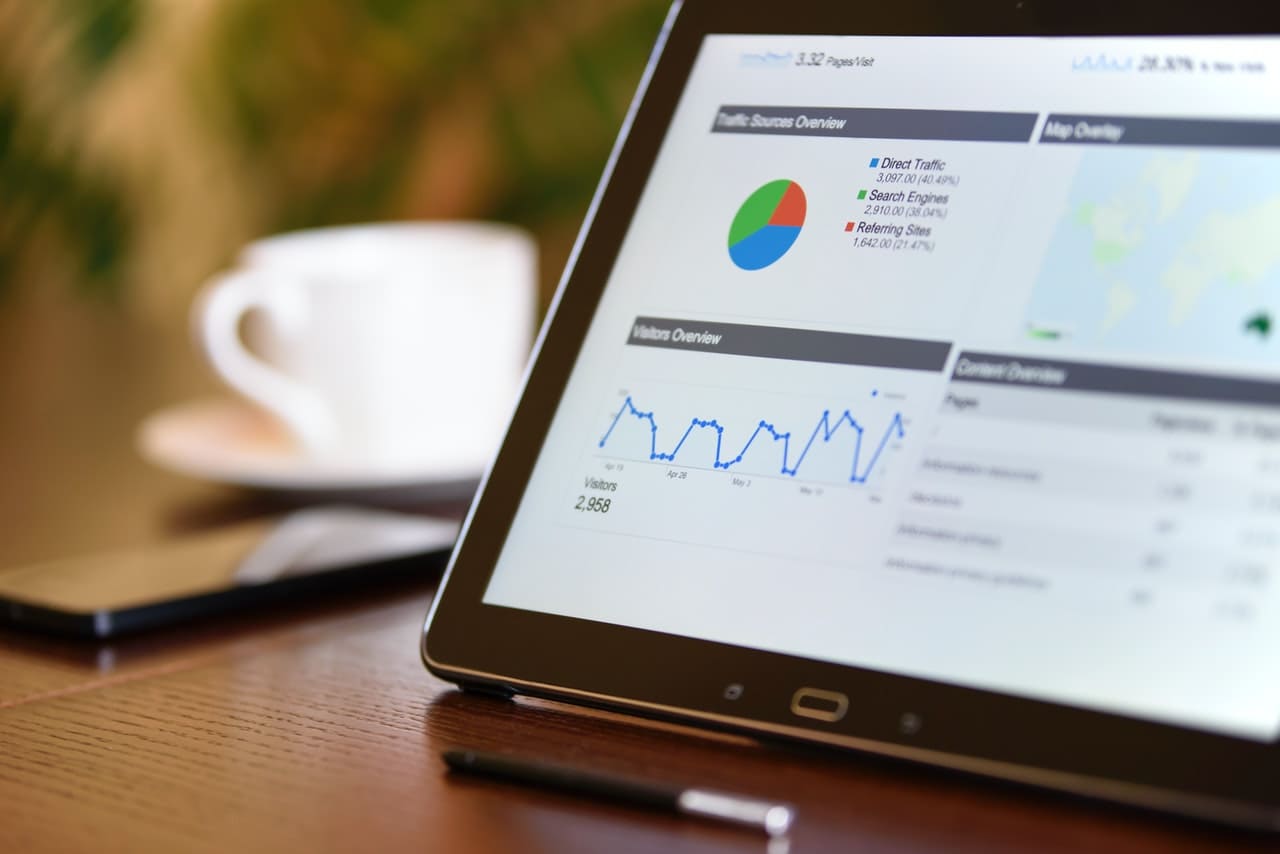Is Google Shopping free for all retailers?
12/11/20
6'
In light of the Covid-19 pandemic, it’s now free to sell products on Google Shopping ads. After years of sponsored ads, this is an excellent opportunity for all sellers, whatever the size of their business or the way they operate. More than just a commercial offer for retailers, this decision reflects the growing competition from Amazon in the online shopping and advertising market.
How does Google Shopping work?
Google Shopping (formerly known as Froogle and then Google Product Search) is a comparator that allows retailers to display their products on Google according to the searches made by browsers.
In addition to the text ads (SEA), Google displays Shopping Ads on the search results page that present a photo of the product as well as a title, price, etc.
Ads are visible on the search results page but also via the “Shopping” tab:

Free ads on Google Shopping and Google Search
Since 2012, Google Shopping has only listed sponsored ads on its interface. Any seller wishing to see their products promoted had to allow an advertising budget (cost per click), and consumers only had access to sponsored products. The announcement of free listings has shaken up the marketing world, particularly for brands lacking a budget or looking for visibility. Any online retailer can now list their products on Google Shopping for free, whether they advertise there or not.
Announced at the end of April, this change was carried out in two stages. In April, Google gave advertisers the opportunity to list their products in the Shopping tab at no charge. Then, at the end of June, a second step was taken in the United States as Google allowed free listings the search page results (only for the knowledge panel format).
In Europe, the Middle East, and Africa, Google launched free product listings on the Shopping tab mid-October.
Of course, not all ads will be free. Sponsored ads remain topical. They will continue to appear at the top of the page in addition to free ads, which are likely to become more showcased. We find the same system as for text ads, where paid results appear above organic/free (SEO) results.
In a twist at the end of July, Google took the free services one step further by announcing sales commissions would be removed (United States only) in a bid to bring more sellers and products to Shopping Actions. Currently, commissions on Google Shopping vary from 5% to 15% depending on the products.
What are the benefits of the free service for retailers on Google Shopping?
For Google, the official objective is twofold: to respond to the growing demand for online sales and to support businesses hit hard by the closures of physical stores following the Covid-19 crisis. On the one hand, consumers benefit from a wider choice, allowing Google to cater to their expectations and budget better. On the other, retailers benefit from direct access to hundreds of thousands of potential buyers across the country or around the world, to sell off their stocks and reconnect with their consumers. Between the two, Google attracts more sellers and strengthens its position in the e-commerce sector… boosting its Shopping Actions service and sponsored ad sales in the long term.
According to the company, “billions of dollars in sales for brands and retailers in the U.S.” would be expected, coupled with “a significant increase in user engagement, with clicks and impressions increasing significantly for merchants“.
A long-term winning strategy for Google

To understand Google’s final objective in this action, we need to go back to the market context.
The growth in Amazon’s advertising revenues in recent years has begun to overshadow Google. Amazon’s growing product searches have encroached on those of Google and Microsoft.
According to a forecast study by eMarketer, for the first time in 2020, Google’s advertising revenue is expected to fall by 5.3% compared to last year. At the same time, Amazon’s advertising revenue should increase by 30%.
Alarm bells are ringing at Google, who have decided to strike back hard by offering Google Shopping for free. By expanding their catalog of advertisers, Google will be able to enrich their product offer and become an essential shopping destination for Internet users. On the other hand, it will continue to compete with other merchants to increase its advertising revenue while offering a free service!
The increase of products on offer, and therefore the competition, should provide a real gain in visibility to sellers operating in niche sectors, on the contrary, other retailers could see their products drown in the masses. In the long term, retailers should consider complementing their free ads with sponsored ads to stand out. The CPC for these ads will probably increase due to the growing competition between advertisers.
How to sell for free on Google Shopping
For companies already present on Google Shopping: all products posted on the Merchant Center are automatically eligible to be listed for free, provided the “Google Platforms” program is activated (checkbox in “Participation in Google Platforms”). Advertisers who have integrated their product catalog via an API will have to enter a new value in an attribute, while those who use a CSV feed will have to indicate this in the settings of their feed.
For retailers who have an e-commerce site without a Google Merchant Center account, you will need to start by creating the account associated with your business. The conditions of use and the precise rules to be respected are communicated at this stage. You will then be able to create and import the your product feeds to be listed on Google Shopping.
You can find all set up details on the Google Merchant Center Help page.
Don’t have an online sales site? Any company can sell via free Google Shopping ads thanks to the Shopping Actions platform: the buyer clicking on your product will be redirected to the Google marketplace, rather than to an external site.
A healthier and more complete sales ecosystem
To simplify e-commerce for all sellers, whatever their size or strategy, the firm has also announced that it wants to improve its ecosystem. In addition to free product listings on Google Shopping and the elimination of sales commissions, a partnership between Google and PayPal or Shopify will link merchants’ accounts for better integration. Collaborations with WooCommerce and BigCommerce are also constantly being improved, to facilitate stock and product management.
At Lengow, we have been a Google Shopping partner since 2017, enabling companies to get the most out of the channel’s different functionalities. As the performance of a Google Shopping campaign is directly linked to the quality of the information associated with it, Lengow has a real impact for brands and retailers, enabling you to optimize and structure the data sent to Google.
Conclusion? Google wants to democratize online sales. And while all businesses can’t win, few will lose.
Sell more with Google Shopping
Increase your sales with Google Shopping and Lengow Discover our new G…
Learn moreImage: Pexels
Your e-commerce library
E-commerce for Retailers
Learn moreE-commerce for Brands
Learn moreL'Oréal Luxe Success Story
Learn moreSign up for our newsletter
By submitting this form you authorize Lengow to process your data for the purpose of sending you Lengow newsletters . You have the right to access, rectify and delete this data, to oppose its processing, to limit its use, to render it portable and to define the guidelines relating to its fate in the event of death. You can exercise these rights at any time by writing to dpo@lengow.com

Trending Posts
Marketing channels
Where does Gen Z shop online?
Gen Z online shopping is transforming the digital marketplace, setting trends that redefine what it means to engage with brands…
16/04/24
9'
Marketplaces
The Top 10 Marketplaces in Europe
The e-commerce scene is a vibrant mix of marketplaces in Europe. These aren't just websites; they're bustling hubs where millions…
08/12/23
7'
Marketplaces
Lengow Now Fully Supports Zalando Logistics Solutions ZSS and ZRS
Zalando, one of Europe’s leading fashion marketplaces, continues to raise the bar with its advanced logistics and fulfillment programs. After…
12/12/24
4'
Marketplaces
How to win the Buy Box on Marketplaces (Amazon, Zalando, etc.)
What is the most important thing for marketplace sellers? Exactly, the Buy Box! If you don't have the Buy Box…
02/04/24
10'
Marketplaces
How to Sell on Temu? Best Tips
Emerging under the vast umbrella of PDD Holdings Inc., Temu has skyrocketed in popularity as a shopping sensation from China…
17/08/23
5'




